How to Clean Burnt Calphalon Pans
To clean burnt Calphalon pans, start by understanding your pan's material. For stubborn stains, try the boiling method: fill the pan with water, add dish soap, and simmer for 15-20 minutes. Alternatively, use a vinegar and baking soda solution. Create a paste with baking soda and water, apply it to the burnt areas, and let it sit for 15-30 minutes before scrubbing gently. Always avoid abrasive scrubbers and harsh detergents to protect the non-stick surface. For severely burnt pans, consider professional cleaning services. Regular maintenance, like hand-washing after each use and proper storage, can prevent future issues. The following tips will help you restore your Calphalon cookware to its former glory.
This post may contain affiliate links. If you make a purchase through these links, I may earn a commission at no additional cost to you. Additionally, portions of this post may be generated using artificial intelligence (AI) technology. While we strive for accuracy, please be aware that AI-generated content may not always be perfect and should be fact-checked when necessary.
The Spatula Scoops
- Use the boiling method by simmering water with dish soap for 15-20 minutes to loosen burnt-on residue.
- Create a vinegar and baking soda solution, letting it sit for 15-30 minutes before gently scrubbing.
- Soak severely burnt pans in equal parts water and white vinegar for 30-60 minutes, then scrub gently.
- Apply a baking soda paste to burnt areas, let sit for 15-30 minutes, and scrub with a soft sponge.
- Avoid damaging non-stick surfaces by using soft sponges and gentle cleaning methods instead of abrasive scrubbers.
Understanding Calphalon Pan Materials
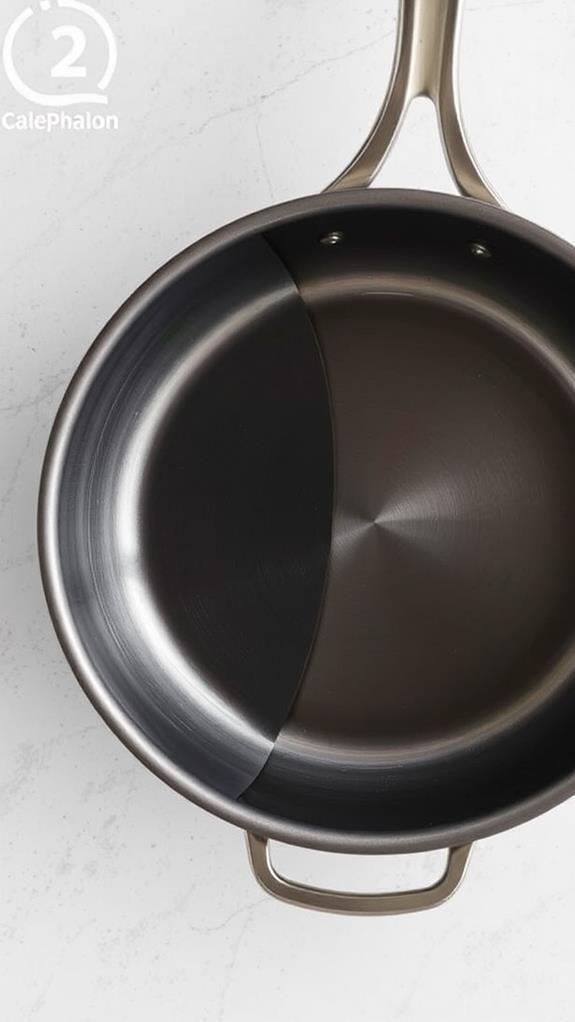
When it comes to cleaning burnt Calphalon pans, understanding the material they're made of is crucial. Calphalon Cookware offers various options, each with unique properties that affect cleaning methods. The most common Calphalon pans are made from hard-anodized aluminum, which undergoes a process that hardens the metal and creates a smooth, nonstick surface. This material is highly durable and resistant to corrosion, making it simpler to clean in most cases. Much like cast iron skillets, Calphalon pans require proper care and maintenance to confirm peak performance and longevity.
If you're dealing with Calphalon's stainless steel cookware, you'll find it excels at even heat distribution and searing. However, it may require different cleaning techniques compared to nonstick surfaces. For those with ceramic Calphalon pans, you'll appreciate the PTFE- and PFOA-free nonstick interior, which allows for easy food release and cleaning. Lastly, if you're working with cast iron Calphalon pans, remember that they offer excellent heat retention and browning capabilities but need proper seasoning and maintenance.
Understanding these materials will help you choose the most effective and safe cleaning method for your burnt Calphalon pan, confirming you don't damage the surface while restoring it to its original condition.
Boiling Method for Stubborn Stains
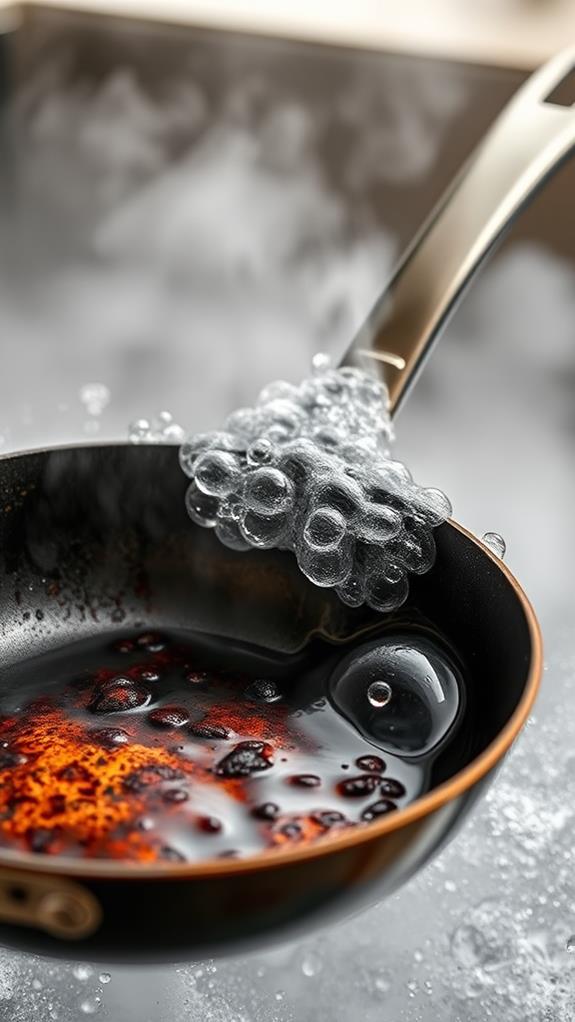
For particularly stubborn stains on your Calphalon pans, the boiling method can be a game-changer. This technique harnesses the power of hot water to loosen burnt-on residue and make cleaning easier. To begin, fill your pan with about an inch of water and place it on the stove. Bring the water to a boil and let it simmer for 15-20 minutes. As the water boils, you'll notice food particles starting to lift from the surface. This method is similar to the seasoning and care process for cast iron skillets, which also involves heat and moisture to maintain the cooking surface.
After simmering, carefully pour out the hot water and let the pan cool slightly. Use a non-abrasive sponge or soft cloth to wipe away the loosened debris. For extra cleaning power, you can add a tablespoon of dish soap to the boiling water. This method is especially effective for removing stubborn grease and caramelized sugars.
If some stains persist, repeat the process or try adding a cup of white vinegar to the water for added cleaning strength. Remember, never use metal utensils or abrasive scrubbers on your Calphalon pans, as these can damage the non-stick surface. With patience and the right technique, you'll have your pans looking like new again.
Vinegar and Baking Soda Solution

You'll find that vinegar and baking soda create a powerful, yet natural cleaning combination for your burnt Calphalon pans. This non-abrasive method effectively breaks down stubborn food residue without damaging the non-stick surface. Much like the dual-blade design of modern kitchen tools, this cleaning solution offers versatility and efficiency in tackling tough messes. By using common household ingredients, you can safely restore your cookware's interior with minimal effort and maximum results.
Powerful Cleaning Combination
The first sentence in the [TEXT] is: The combination of vinegar and baking soda creates a powerful cleaning solution for burnt Calphalon pans.
This mixture works effectively due to the chemical reaction between the acidic vinegar and alkaline baking soda. You'll start by creating a solution of equal parts white vinegar and water. Then, sprinkle baking soda over the affected area. As the two ingredients interact, they'll form a fizzing reaction that helps loosen burnt residue.
Here's a quick guide to using this cleaning method:
| Step | Action | Time |
|---|---|---|
| 1 | Apply mixture | Immediately |
| 2 | Let sit | 15-30 minutes |
| 3 | Scrub gently | As needed |
| 4 | Rinse | Thoroughly |
| 5 | Dry | Completely |
Allow the solution to work for 15-30 minutes, replenishing the vinegar as it dries. Use a soft sponge to gently scrub away the loosened residue. For tougher stains, you might consider using Bar Keepers Friend® cleanser with a soft sponge for extra cleaning power. Rinse the pan thoroughly with warm water to remove any remaining solution. Finally, dry the pan completely to prevent new stains from setting in.
Natural, Non-Abrasive Method
Looking for a gentle yet effective way to clean your burnt Calphalon pans? The vinegar and baking soda solution is a natural, non-abrasive method that's perfect for restoring your non-stick pans without damaging their surface.
To begin, create a mixture of equal parts water and distilled white vinegar. Spray this solution over the interior of your pan, ensuring complete coverage. Next, generously sprinkle baking soda over the vinegar mixture. Allow this combination to sit for 15-30 minutes, rejuvenating the vinegar as needed if it dries out.
After the waiting period, use a soft sponge to gently scrub away the loosened grime. This process helps break down stubborn burnt-on food without compromising the non-stick coating. Once you've removed the debris, thoroughly wash and dry your pan.
This method is particularly effective for Calphalon stainless steel and non-stick pans. Remember to always let your pan cool before cleaning and avoid abrasive materials that could scratch the surface. If you need additional guidance, Calphalon Help resources are available for specific care instructions tailored to your pan type.
Avoiding Non-stick Surface Damage
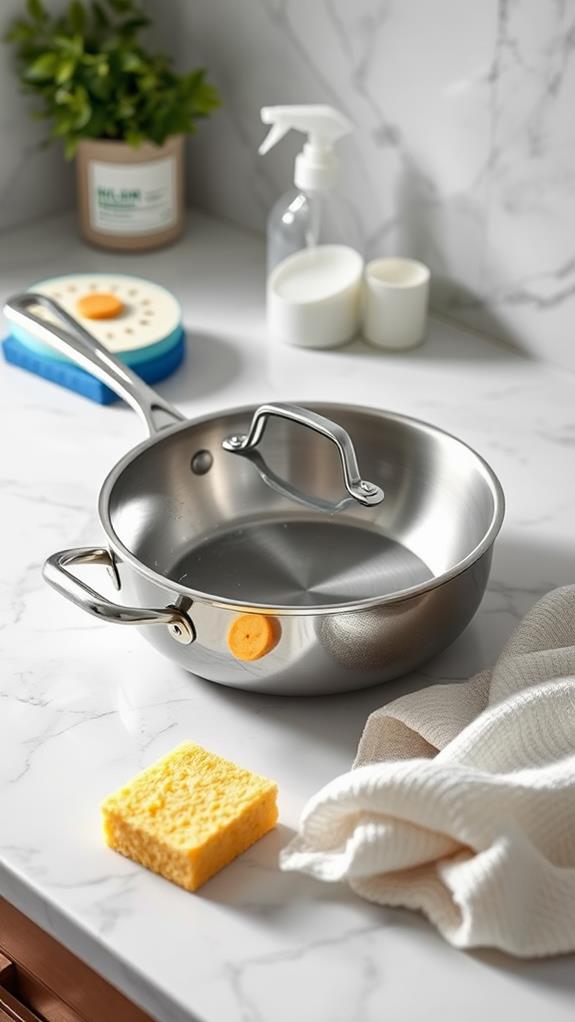
Preserving the non-stick surface of your Calphalon pans is crucial for their longevity and performance. To maintain the integrity of your cookware, you'll need to avoid certain practices that can damage the non-stick coating. First, remember that Calphalon pans aren't typically dishwasher safe. Always hand wash your pans to protect the non-stick surface.
When cleaning, steer clear of abrasive scrubbers and harsh detergents. Instead, opt for gentle cleaning methods using hot water, vinegar, or baking soda. Use a soft sponge or pad and scrub in circular motions to prevent scratching. For cooking, choose wooden, silicone, or nylon utensils over metal ones to avoid damaging the coating.
| Do | Don't |
|---|---|
| Hand wash | Use dishwasher |
| Use gentle cleaning methods | Use harsh detergents |
| Scrub with soft sponge | Use abrasive scrubbers |
| Clean in circular motions | Scrub aggressively |
| Use non-metal utensils | Cook with metal utensils |
Professional Cleaning Services Benefits

While proper home care is important, sometimes your Calphalon pans need extra attention. That's where professional cleaning services come in. These experts guarantee a thorough and efficient cleaning of your cookware, preventing the buildup of stubborn stains and residue. By utilizing professional services, you're not only maintaining the longevity and performance of your non-stick pans but also promoting a clean and hygienic cooking environment in your kitchen.
Three key benefits of professional cleaning services for your Calphalon pans:
- Restoration to like-new condition
- Prevention of permanent damage to the non-stick surface
- Time and effort savings for you, the homeowner
Professional cleaning helps avoid the risks associated with improper home cleaning methods, which can potentially harm your cookware's non-stick surface. By regularly investing in professional cleaning, you're verifying that your Calphalon pans remain in top condition for years to come. This approach not only saves you time and effort but also provides peace of mind, knowing that your valuable cookware is being cared for by experts who understand the intricacies of non-stick surfaces and proper cleaning techniques.
Preventive Maintenance Tips
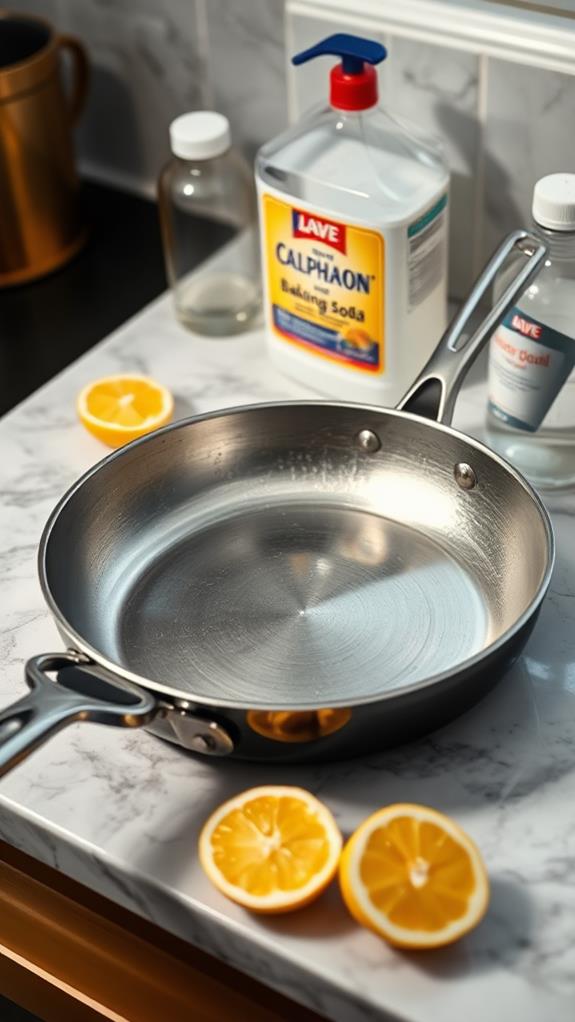
You can greatly extend the life of your Calphalon pans with some simple preventive maintenance tips. Regular hand-washing with mild detergent and a non-abrasive sponge guarantees burnt-on residue buildup is prevented. After washing, dry your pans thoroughly to avoid water spots and discoloration. When storing, place paper towels or trivets between stacked pans to ensure scratches are prevented and the nonstick surface is maintained.
Avoid using aerosol cooking sprays, as they can damage the nonstick coating. Instead, opt for oil or butter applied directly to the pan. Preheating your Calphalon pans before adding food promotes even cooking and decreases the likelihood of ingredients sticking and burning.
Action | Frequency | Benefits |
| —————— | —————— | —————————– |
|---|---|---|
| Hand-wash | After each use | Prevents residue buildup |
| Dry thoroughly | After washing | Minimizes water spots |
| Proper storage | Always | Protects nonstick surface |
| Avoid sprays | During cooking | Preserves nonstick coating |
| Preheat | Before cooking | Guarantees even heat distribution |
Restoring Severely Burnt Pans
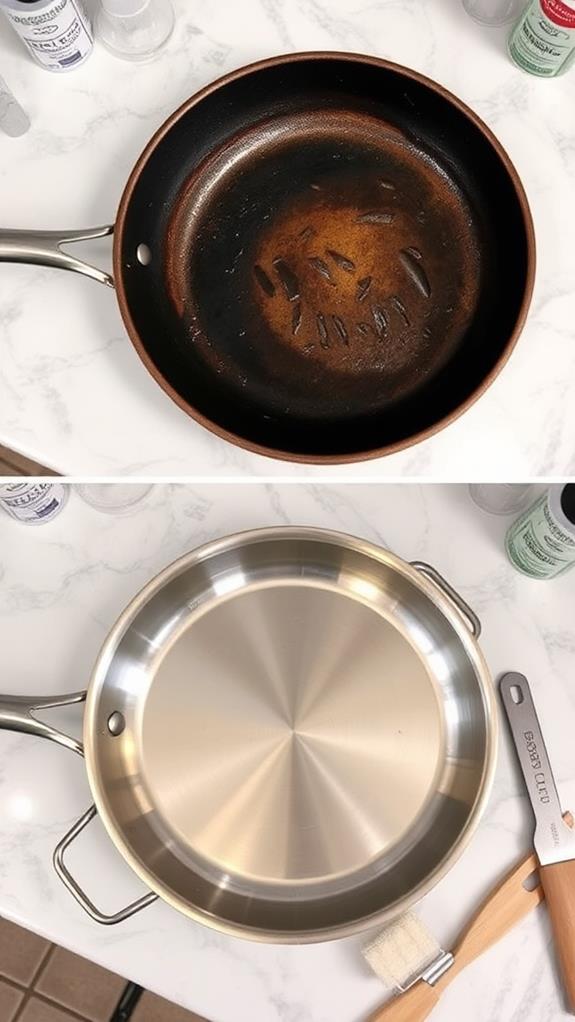
When faced with a severely burnt Calphalon pan, you'll want to start by evaluating the extent of the damage. Once you've determined the severity, soak the pan in a vinegar solution to help loosen stubborn residue and stains. After soaking, apply a paste made from baking soda and water, gently scrubbing with a soft-bristled brush to restore the pan's original shine.
Assess Damage First
Before diving into cleaning methods, it is crucial to assess the extent of damage to your severely burnt Calphalon pan. Carefully inspect the cookware for signs of warping, flaking, or other structural issues that might indicate irreparable damage. If you notice extensive heat damage, it is possible that the anodized coating has been compromised, resulting in a dull, discolored exterior and potential adhesion problems with the nonstick interior.
In cases of extreme charring or melted components, you'll need to evaluate whether professional reconditioning or replacement is the best course of action. Here's what you should keep in mind:
- Your pan's original functionality may be compromised
- The cost of reconditioning might outweigh the pan's value
- Safety concerns may arise from using damaged cookware
To make an informed decision, it is advisable to consult Calphalon's customer support team. They can help determine if your severely burnt pan is a candidate for their in-house reconditioning service or if replacement is the better option. Remember, while it is tempting to try DIY methods, some damage may require professional intervention to restore your cookware's original functionality and appearance.
Soak in Vinegar Solution
A vinegar solution soak can work wonders for severely burnt Calphalon pans. To start, mix equal parts water and distilled white vinegar in your pan. Let it sit for 30-60 minutes, allowing the acidic solution to break down and loosen stubborn, burnt-on food residue.
After soaking, gently scrub the pan's surface with a soft sponge or nylon scrub pad. You'll notice the loosened grime coming off easily, revealing the original surface underneath. Rinse thoroughly with hot water to remove any remaining vinegar or food particles, then dry completely before use.
For particularly stubborn burns, you might need to repeat this process. The vinegar's acidity is key in dissolving even the most tenacious burnt-on food without damaging the nonstick coating.
Here's a quick reference guide for the process:
| Step | Action | Duration |
|---|---|---|
| 1 | Mix solution | 1 minute |
| 2 | Soak pan | 30-60 minutes |
| 3 | Scrub gently | 5-10 minutes |
| 4 | Rinse & dry | 2-3 minutes |
| 5 | Repeat if needed | As necessary |
Use Baking Soda Paste
Baking soda paste is a powerhouse cleaning solution for severely burnt Calphalon pans. To use this method, create a thick paste by mixing baking soda with water. Spread this paste generously over the burnt areas of your pan, guaranteeing complete coverage. Let it sit for 15 to 30 minutes, allowing the alkaline properties of the baking soda to break down and lift stubborn food debris.
After the waiting period, it's time to scrub. Use a soft sponge or non-abrasive pad to work the paste into the burnt areas. You'll notice the stains starting to lift as you scrub. Once you're satisfied with the results, rinse the pan thoroughly with hot water to remove all traces of the baking soda paste.
Remember these key points when using this method:
- Be patient – the baking soda needs time to work its magic
- Avoid using abrasive materials that could damage your pan's surface
- Ensure complete drying to prevent rusting or further corrosion
This technique is particularly effective for restoring severely burnt pans. By following these steps, you'll be able to revive your Calphalon cookware and extend its lifespan, saving you money and frustration in the long run.
Frequently Asked Questions
How Do You Get Burn Marks Out of Calphalon?
To remove burn marks from your Calphalon pans, you'll want to start with gentle methods. First, try boiling water with a few drops of dish soap in the pan. This helps break down grease and loosen burnt residue. If that doesn't work, create a mixture of equal parts water and white vinegar, spray it on the pan's interior, sprinkle baking soda, and let it sit for 15-30 minutes. Then, scrub away the loosened grime. Avoid abrasive scrubbers or harsh chemicals to protect the non-stick coating.
How Do You Restore Calphalon Pans?
Like breathing new life into an old friend, restoring Calphalon pans is a rewarding process. You'll want to start by tackling any stubborn burns or stains. Boil a mixture of water and dish soap in the pan, then soak it in vinegar and baking soda. Gently scrub with a soft sponge. For the exterior, use Bar Keepers Friend to bring back the shine. Remember, hand-washing and thorough drying are key to maintaining your pan's condition and preventing future damage.
How Do You Deep Clean Calphalon Pans?
To deep clean your Calphalon pans, start by boiling water with dish soap in the pan to loosen tough residue. For stubborn stains, try a vinegar and baking soda mixture. Avoid abrasive scrubbers or harsh detergents that can damage the non-stick coating. Regular maintenance is indispensable for optimal performance. If you're dealing with severely burnt pans, consider professional cleaning services. Remember, proper care extends the lifespan of your cookware and guarantees its non-stick properties remain effective.
Can I Clean Calphalon With Vinegar?
Yes, you can clean Calphalon with vinegar. It's an effective and gentle cleaning solution for your cookware. You'll want to mix equal parts water and distilled white vinegar, then apply it to the interior of your pan. Let it sit for 15-30 minutes before scrubbing with a soft sponge. For tougher stains, try combining vinegar with baking soda. After cleaning, be sure to rinse thoroughly and dry your pan to maintain its quality and performance.





